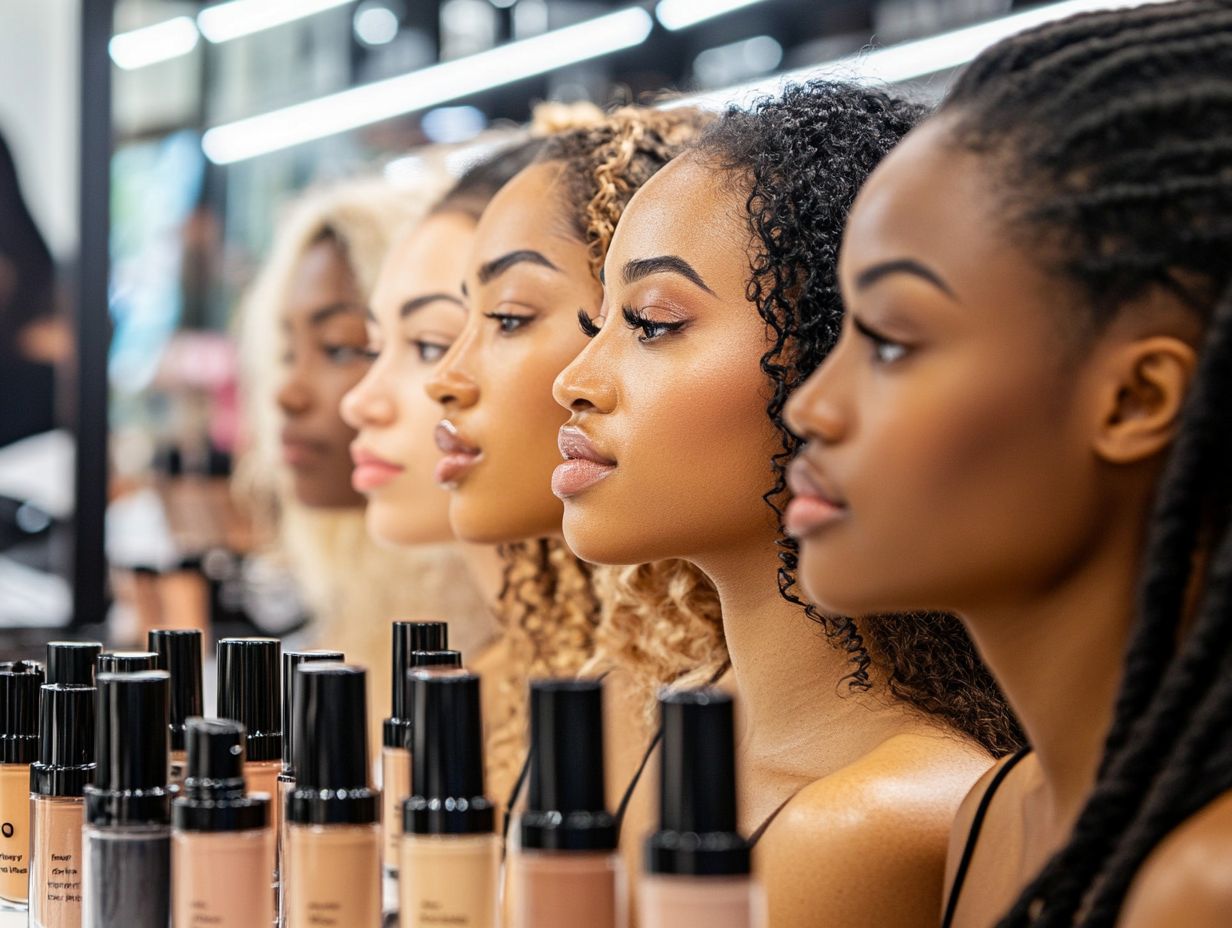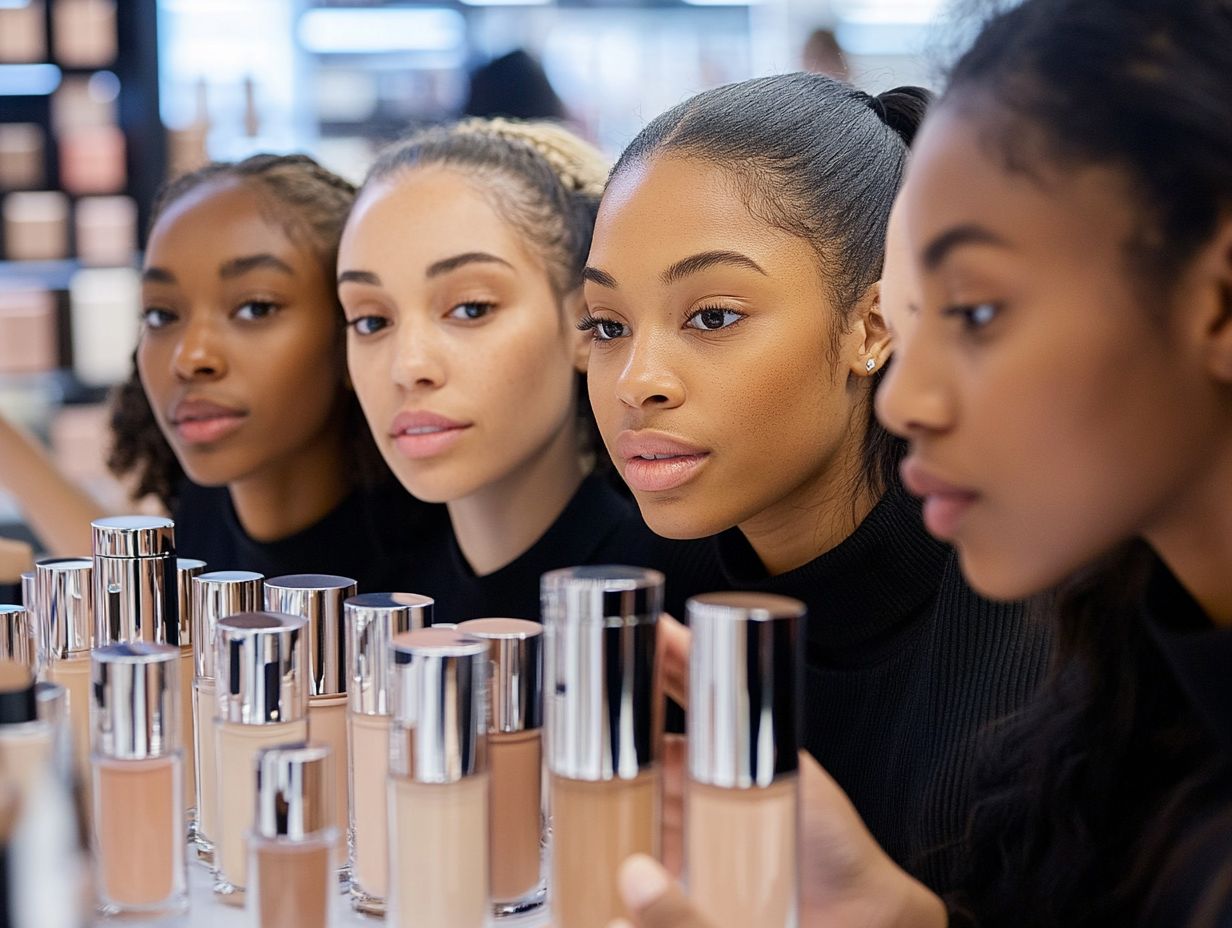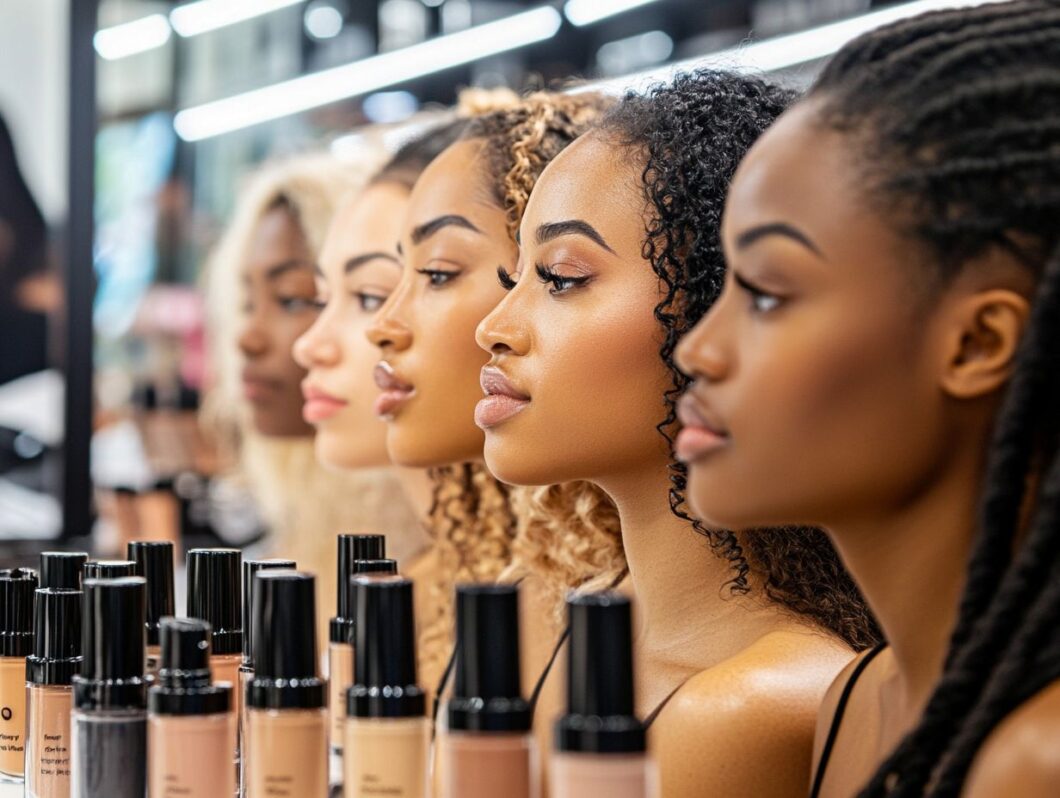Finding the perfect foundation match can often feel like searching for a needle in a haystack. With an overwhelming array of shades and formulas available, it’s essential to ensure that my choice enhances my natural beauty.
This guide simplifies the process into five straightforward steps, starting with understanding my skin tone and type, and moving on to selecting the appropriate formula and shade.
I will discover effective application techniques and learn tips for maintaining a flawless look throughout the day. I’m preparing to embrace my best complexion yet!
Key Takeaways:
Understanding Your Skin Tone

Understanding my skin tone is essential for selecting the perfect foundation and achieving a flawless makeup look. Skin tone can vary significantly among individuals, influenced by factors such as genetics and environmental exposure.
Typically, I categorize skin tones into three groups: warm, cool, and neutral, each defined by specific undertones that impact how colors appear on the skin.
By identifying these undertones, I can effectively match foundation shades and enhance my overall makeup application, ensuring that my complexion radiates the desired natural glow.
Determining Your Undertone
Determining my undertone is crucial for selecting the right foundation shade that complements my natural complexion. By understanding the nuances of undertones, I can make informed decisions that enhance my overall appearance. For guidance on this process, check out How to Find Your Perfect Foundation Match in 5 Steps.
There are several effective methods to identify undertones, such as examining the color of my veins; bluish veins typically indicate cool undertones, while greenish hues suggest warm tones. Additionally, testing with jewelry can provide valuable insights—gold usually flatters warm undertones, whereas silver tends to suit cooler skin. Those with neutral undertones often find that both metals work equally well for them.
Each of these undertones has distinct characteristics that influence not only foundation selection but also the range of colors that harmonize beautifully with my skin tone.
Identifying Your Skin Type
Identifying my skin type is a critical step in selecting the appropriate foundation formula that meets my individual needs. Understanding whether my skin is oily, dry, combination, or sensitive significantly influences not only my choice of foundation but also how it is applied for optimal results.
For instance, I have found that individuals with oily skin often benefit from matte or oil-free foundations that effectively control shine and provide a longer-lasting finish. Conversely, those with dry skin should seek out hydrating or dewy formulas that nourish and illuminate the complexion.
For my combination skin, I prefer a sheer to medium coverage foundation that strikes the right balance, allowing for targeted application that addresses both oily and dry areas effectively. If I have sensitive skin, I prioritize hypoallergenic, fragrance-free options, opting for lightweight mineral foundations that minimize irritation while delivering a natural finish.
By embracing the unique characteristics of each skin type, I can enhance my natural beauty and feel confident and radiant.
Choosing the Right Foundation Formula

Choosing the right foundation formula is fundamentally based on a thorough understanding of my skin type and the desired coverage levels for achieving a flawless finish.
Whether I opt for a lightweight tinted moisturizer or a full-coverage foundation, the range of options available caters to various skin types and preferences.
Some foundations are specifically designed to provide hydration, incorporating ingredients like hyaluronic acid, while others are formulated to control oil for those with oily skin.
By matching the formula to my skin type, I not only ensure comfort but also enhance the overall appearance of my makeup, allowing for a fresh look that lasts throughout the day.
Matching Your Skin Type to Foundation Formula
Matching my skin type to the appropriate foundation formula is essential for achieving an even complexion and ensuring long-lasting wear.
Choosing the right foundation goes beyond mere preference; it is important to understand my skin’s unique needs. For example, individuals with oily skin should consider a matte foundation that helps control shine and provides a smooth finish throughout the day.
In contrast, those with dry skin might benefit from hydrating formulas that contain moisturizing ingredients, delivering the nourishment necessary for a healthy glow.
In terms of coverage, I find that lighter formulas work well for casual outings or midday events, while full-coverage options are best reserved for special occasions or evenings out, guaranteeing a flawless appearance in any situation.
Finding the Right Shade
Finding the right shade of foundation is a crucial component of the makeup application process that can significantly influence the overall look.
With numerous options available, it is essential to know how to effectively match foundation to my unique skin tone. Whether I decide to swatch foundation in-store or utilize virtual foundation matching tools like the Laura Mercier Foundation Finder, understanding my complexion is key to achieving a natural finish.
Testing various shades against my makeup-free face enables me to find the perfect match that enhances my features and boosts my confidence.
Testing and Swatching Foundations

Testing and swatching foundations on my skin is an essential part of the foundation selection process, ensuring that I find the perfect shade. This step allows me to assess not only the color but also how well it complements my natural complexion and undertones.
When swatching, I find it advisable to apply the foundation along my jawline or on my wrist, as these areas provide a more accurate reflection of how the shade will perform on my face. After application, I recognize that patience is crucial; waiting a few minutes allows the foundation to oxidize, which can affect its final appearance. Observing the color against my skin in natural light is particularly helpful in identifying any discrepancies.
I also take into account the foundation’s finish—whether matte, dewy, or satin—and its texture, as these factors significantly influence the overall look.
By blending a small amount onto my skin and evaluating its coverage and feel, I can make an informed decision that best suits my needs.
Using Online Shade Matching Tools
Utilizing online shade matching tools, such as the Laura Mercier Foundation Finder, significantly streamlines the process of identifying my ideal foundation shade.
These innovative resources leverage advanced algorithms and extensive databases to match users with products that align with their specific skin tone and undertones, offering a more customized approach than traditional testing methods alone.
By uploading a selfie or completing a brief questionnaire regarding my complexion, these tools intelligently analyze various factors, including warmth, coolness, and depth of color, to provide precise recommendations.
This personalized experience not only saves time and effort for individuals seeking the right shade but also alleviates the frustration that often accompanies guesswork.
By embracing such online tools in conjunction with traditional swatches and in-store testers, I can enhance my makeup shopping strategy, ensuring that my final choice complements my unique skin characteristics beautifully.
Applying Foundation for a Perfect Match
Applying foundation correctly is essential for achieving a seamless and natural finish that enhances my overall makeup look. The application process involves several key steps, starting with prepping my skin to create a smooth canvas for the foundation.
Proper skin preparation includes cleansing, moisturizing, and priming, all of which help the foundation adhere better and last longer. Additionally, utilizing the right techniques for applying foundation—whether with a brush, sponge, or my fingers—can significantly influence the final result.
By mastering these methods, I can ensure that my foundation matches perfectly with my complexion.
Prepping Your Skin for Foundation

Prepping my skin for foundation is an essential step in achieving a smooth and flawless makeup application.
I always take the time to properly cleanse, exfoliate, and moisturize, as this lays the groundwork for any makeup look. I start with a gentle cleanser to remove impurities, followed by a mild exfoliant that helps eliminate dead skin cells and promotes a radiant complexion.
Once my skin is clean and prepped, I apply a lightweight moisturizer to hydrate and plump the skin, creating an ideal canvas for makeup. A quality primer is also crucial; it enhances the appearance of foundation by filling in fine lines and pores, ensuring an even finish and extended wear.
By following these essential steps, I not only elevate the performance of my makeup but also keep my skin looking healthy and vibrant throughout the day.
Techniques for Applying Foundation
I recognize that various techniques for applying foundation can significantly influence the overall appearance and longevity of my makeup.
Each method presents unique benefits tailored to different skin types and desired effects. For example, using a brush allows me to achieve a flawless, airbrushed look, which is ideal for covering larger areas smoothly.
On the other hand, dampened sponges can enhance the foundation’s natural finish, facilitating seamless blending and creating a skin-like effect. Additionally, applying foundation with my fingers provides warmth, helping the product meld into the skin, making it particularly useful for quick touch-ups.
To master blending, I find it essential to work in circular motions and layer products gradually. This approach ensures even coverage while avoiding any cakiness.
Maintaining Your Perfect Match
Maintaining a flawless appearance throughout the day is crucial for keeping my makeup looking fresh and polished. I understand that factors such as my skin type and environmental conditions can influence how well my foundation wears, often necessitating touch-ups or adjustments.
To address this, I implement a few strategic tips to extend the life of my foundation. By regularly assessing my makeup and utilizing setting sprays, I can enhance its longevity and ensure that my foundation shade remains consistent, allowing me to confidently face any occasion.
Tips for Touch-Ups and Adjustments
Implementing effective tips for touch-ups and adjustments allows me to maintain my foundation’s flawless appearance throughout the day.
To achieve a polished look, I find that using a translucent powder to control shine is essential, particularly in the T-zone, where oil tends to accumulate the most. This quick addition not only sets my foundation but also provides a fresh finish without feeling heavy.
When certain areas, such as under the eyes or blemishes, require a bit more attention, I apply a lightweight concealer that can work wonders. It’s important for me to step back and assess my overall look in natural light because subtle tweaks can significantly enhance my complexion, ensuring that I radiate confidence all day long.


